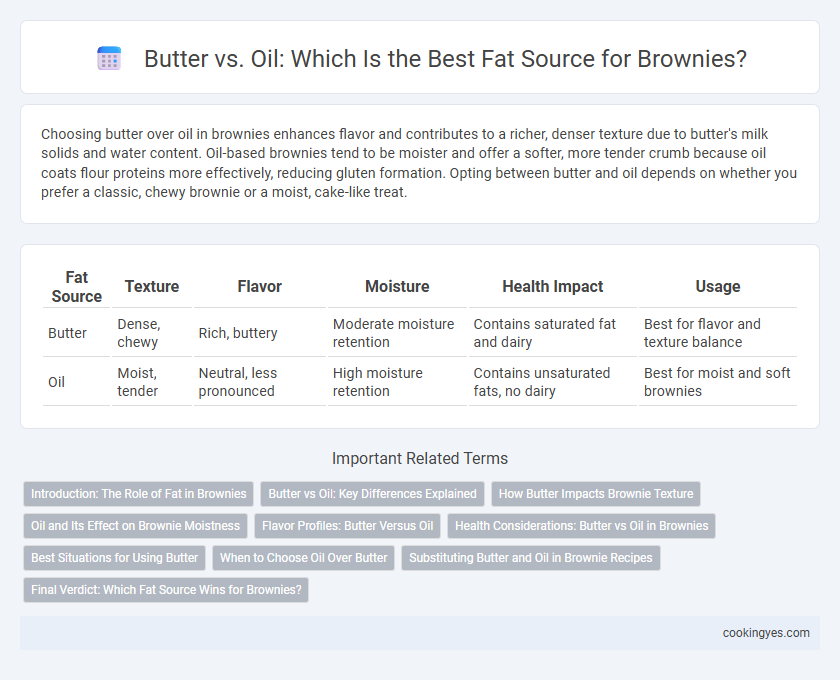Choosing butter over oil in brownies enhances flavor and contributes to a richer, denser texture due to butter's milk solids and water content. Oil-based brownies tend to be moister and offer a softer, more tender crumb because oil coats flour proteins more effectively, reducing gluten formation. Opting between butter and oil depends on whether you prefer a classic, chewy brownie or a moist, cake-like treat.
Table of Comparison
| Fat Source | Texture | Flavor | Moisture | Health Impact | Usage |
|---|---|---|---|---|---|
| Butter | Dense, chewy | Rich, buttery | Moderate moisture retention | Contains saturated fat and dairy | Best for flavor and texture balance |
| Oil | Moist, tender | Neutral, less pronounced | High moisture retention | Contains unsaturated fats, no dairy | Best for moist and soft brownies |
Introduction: The Role of Fat in Brownies
Fat is essential in brownies, influencing texture, moisture, and flavor. Butter provides a rich, creamy taste and contributes to a tender crumb due to its milk solids and water content. Oil creates a denser, moister texture, making brownies more fudgy and less cakey.
Butter vs Oil: Key Differences Explained
Butter and oil significantly impact brownie texture and flavor; butter provides a rich, creamy taste with a denser, fudgier texture due to its milk solids and water content, while oil delivers a moister, lighter crumb because it is 100% fat. Butter's ability to emulsify ingredients creates a tender, slightly chewy brownie crust, whereas oil's neutral flavor allows other flavors to stand out and yields a more uniform, softer bite. Choosing butter enhances taste complexity and structure, whereas oil optimizes moisture retention and softness in brownies.
How Butter Impacts Brownie Texture
Butter enhances brownie texture by contributing a rich, creamy mouthfeel and creating a tender crumb due to its milk solids and water content. When melted and incorporated, butter promotes a denser, fudgier consistency compared to oil, which results in a lighter, cakier texture. The emulsification of butter with sugar also helps develop a glossy, crackly top crust characteristic of classic brownies.
Oil and Its Effect on Brownie Moistness
Using oil as the fat source in brownie recipes significantly enhances the moistness and tenderness of the final product due to its liquid state at room temperature, which prevents hardening during cooling. Unlike butter, oil coats flour proteins more effectively, reducing gluten formation and resulting in a softer, chewier texture. Studies show that oil-based brownies retain moisture longer, leading to an extended shelf life without compromising flavor.
Flavor Profiles: Butter Versus Oil
Butter provides a rich, creamy flavor and contributes to a denser, fudgier brownie texture due to its milk solids and water content. In contrast, oil yields a moist, tender crumb with a more neutral taste, allowing other ingredients like cocoa or vanilla to stand out. Choosing butter enhances the classic, buttery aroma and depth, while oil results in a lighter flavor profile with a smoother mouthfeel.
Health Considerations: Butter vs Oil in Brownies
Butter contains saturated fats and provides rich flavor and texture to brownies but may raise LDL cholesterol, potentially impacting heart health. Oil, often made from vegetable sources like canola or sunflower, contains unsaturated fats that can promote better cardiovascular health when used in brownies. Choosing oil can result in a moister brownie with fewer saturated fats, while butter offers a more traditional taste but with higher saturated fat content.
Best Situations for Using Butter
Butter is ideal for brownies when seeking a rich, creamy flavor and tender, cake-like texture due to its milk solids and water content. It performs best in recipes that benefit from a balanced structure and slight crispness at the edges, enhancing overall flavor complexity. Use butter in brownies when aiming for a classic, indulgent treat with a melt-in-your-mouth consistency.
When to Choose Oil Over Butter
Oil is the preferred fat source in brownies when a moist, dense texture is desired, as it retains more moisture than butter during baking. Choose oil for vegan or dairy-free brownie recipes, ensuring compatibility with dietary restrictions while maintaining richness. Use oil when a subtle flavor is needed to let other ingredients like chocolate or nuts stand out without the buttery taste.
Substituting Butter and Oil in Brownie Recipes
Butter and oil are common fat sources in brownie recipes, with butter providing a rich flavor and oil contributing to a moist, tender texture. Substituting butter with oil often results in fudgier brownies, while replacing oil with butter enhances flavor but may yield a denser crumb. When swapping, use 3/4 cup of oil for every 1 cup of butter to maintain proper fat content and texture.
Final Verdict: Which Fat Source Wins for Brownies?
Butter delivers richer flavor and a denser, fudgier texture ideal for classic brownies, while oil yields a moister, lighter bite and enhances shelf life. For ultimate indulgence and depth, butter is preferred, as its milk solids contribute to caramelization and complexity. Health-conscious recipes might lean toward oil for lower saturated fat, but butter reigns supreme in traditional brownie quality and taste.
Butter vs Oil for brownie fat source Infographic

 cookingyes.com
cookingyes.com